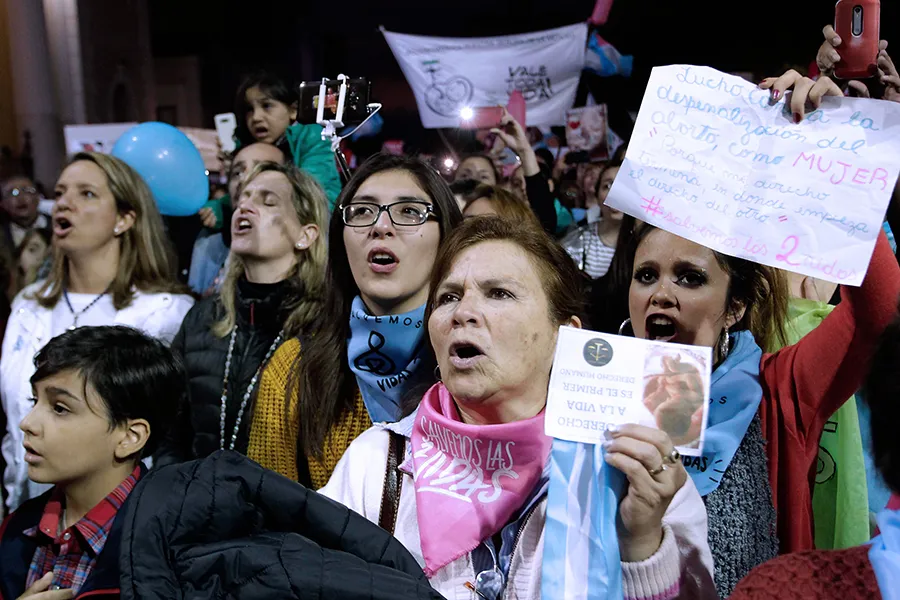
Managua, Nicaragua, Jul 10, 2018 / 04:01 pm (CNA/EWTN News).- A group of bishops in Nicaragua who went Monday to free a group of protesters who had taken refuge in a basilica the previous day were themselves assaulted by a pro-government group.
Protests against president Daniel Ortega which began April 18 have resulted in more than 300 deaths. The country’s bishops have mediated on-again, off-again peace talks between the government and opposition groups.
Cardinal Leopoldo José Brenes Solorzano of Managua, 69; his auxiliary, Bishop Silvio José Baez Ortega, 60; and Archbishop Waldemar Sommertag, 50, apostolic nuncio to Nicaragua, were surrounded July 9 when they tried to enter San Sebastian basilica in Diriamba, about 25 miles south of Managua.
Their route was blocked, and the pro-government groups called them murderers and liars. Among those trapped in the basilica were volunteer medics.
Bishop Baez posted a tweet showing a cut on his arm, and saying, “Besieged by an angry mob who wanted to enter the Basilica of San Sebastian in Diriamba, I was wounded, hit in the stomach, robbed of my episcopal insignia and verbally attacked. I am well, thanks be to God. The basilica was liberated, and those who were within.”
Asediado por una turba enardecida que quería ingresar a la Basílica San Sebastián en Diriamba, fui herido, golpeado en el estómago, me arrebataron las insignias episcopales y agredido verbalmente. Estoy bien gracias a Dios. Se liberó la basílica y a quienes allí estaban. pic.twitter.com/9qTgugBjic
— Silvio José Báez (@silviojbaez) July 9, 2018
The Archdiocese of Managua called the attack committed “by persons close to the government and paramilitaries” was “condemnable and repudiable.”
The bishops were visiting Diriamba after what the Nicaraguan Centre for Human Rights reported as deadliest day in the country since the country’s unrest began more than two months ago.
The rights group said that 38 people were killed during clashes July 8. Of these, 31 were anti-government protesters, four were police officers, and three were members of pro-government groups. Most of those killed were in Diriamba and nearby Jinotepe.
The Nicaraguan bishops’ conference said the delegation of bishops was “fulfilling the mission of Jesus Christ, to be at the side of the suffering people, a pastoral visit to the priests and faithful of the Carazo department, the victims of police, paramilitaries and crowds producing death and dolour.”
Cardinal Brenes said he had “felt the brutal force” exercised against his priests. “We have gone to the parishes to console our priests, to accompany them in their suffering, and we have received aggressions.”
«Padre, perdónalos, porque no saben lo que hacen» (Lc 23,34). Orando en la capilla de la Catedral de Managua hoy después de ser agredidos. pic.twitter.com/NiKxORL9lh
— Silvio José Báez (@silviojbaez) July 10, 2018
Barricades and roadblocks are now found throughout the country, and clashes frequently turn lethal. Bishops and priests across Nicaragua have worked to separate protesters and security forces, and have been threatened and shot.
The violence in Diriamba and Jinotepe was focused on police and paramilitaries trying to clear barricades set up and manned by protesters.
Bishop Rolando José Alvarez Lagos of Matagalpa said the government efforts to clear roadblocks were made “at the price of blood and death,” and that the government has become blinded by “arrogance and pride”.
Shortly after the bishops were assaulted in Diriamba, paramilitaries and government sympathizers were profaning and sacking St James the Apostle parish in Jinotepe.
The parish showed on Facebook that it had been desecrated by “persons, paramilitaries accompanied by police forces” who were “destroying pews, tables, and medications”.
The medications had been used in part to provide medical care for those wounded in the July 8 riots in Diriamba.
The profaners threw garbage at the parish’s priests, and threatened to burn the church.
The Nicaraguan bishops’ conference has called off the working groups meant to mediate in the country’s crisis, and protesters are planning a strike July 12.
Nicaragua’s crisis began after Ortega announced social security and pension reforms. The changes were soon abandoned in the face of widespread, vocal opposition, but protests only intensified after more than 40 protestors were killed by security forces initially.
Anti-government protesters have been attacked by “combined forces” made up of regular police, riot police, paramilitaries, and pro-government vigilantes.
The Nicaraguan government has suggested that protestors are killing their own supporters so as to destabilize Ortega’s administration.
The Church in Nicaragua was quick to acknowledge the protestors’ complaints.
The pension reforms which triggered the unrest were modest, but protests quickly turned to Ortega’s authoritarian bent.
Ortega has been president of Nicaragua since 2007, and oversaw the abolition of presidential term limits in 2014.
The Church has suggested that elections, which are not scheduled until 2021, be held in 2019, but Ortega ruled this out July 7.
Ortega was a leader in the Sandinista National Liberation Front, which had ousted the Somoza dictatorship in 1979 and fought US-backed right-wing counterrevolutionaries during the 1980s. Ortega was also leader of Nicaragua from 1979 to 1990.
If you value the news and views Catholic World Report provides, please consider donating to support our efforts. Your contribution will help us continue to make CWR available to all readers worldwide for free, without a subscription. Thank you for your generosity!
Click here for more information on donating to CWR. Click here to sign up for our newsletter.





Leave a Reply